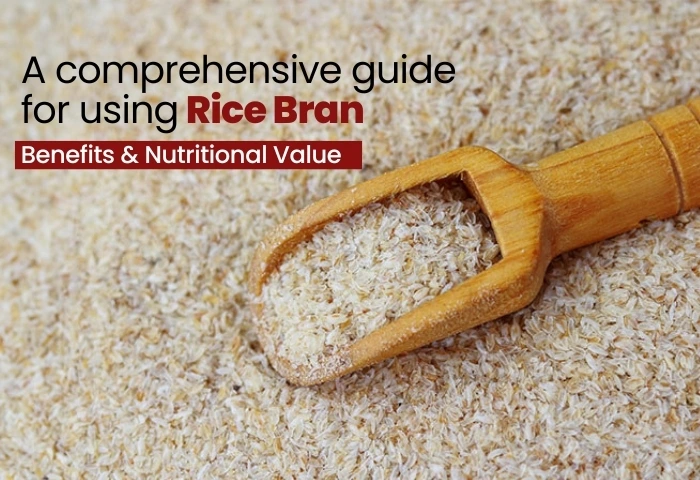Rice bran is widely consumed as a staple food across the world, but few of them are aware of its strong nutritional value, which is present in the outer layers of the grain.
It is obtained as a byproduct of rice milling, which is nutrient-dense and is gaining increasing popularity in the health, skincare, and food industries.
We will deep dive into what rice bran is and its use and explore its various benefits across various categories.
Now the question arises, what exactly is rice bran? It is a brownish outer layer of the rice kernel that consists of the bran and germ and is part of the endosperm.
While rice milling to make white rice, the rice bran is removed along with the husk. It may be discarded, but still it is a rich source of nutrients.
It is full of dietary fiber, healthy fats, proteins, and a variety of vitamins and minerals. The presence of valuable antioxidants such as gamma oryzanol, tocopherols, and phenolic compounds makes it nutritious.
The rice germ and the endosperm distinguish it from other parts of the rice grain. The germ is the reproductive part of the grain that grows into a new plant, while the starchy core is the endosperm. Additionally, it has a longer shelf life than other grains, which is beneficial.
One might think that it is an extract but might not be edible. But rice bran is edible and can be consumed in different ways.
You can find rice bran oil being used in cooking, baking, and smoothies, along with your favorite skincare products.
Benefits of Rice Bran Oil
- Cooking and Food Products–—It is a key ingredient in various food items, particularly in the form of rice bran oil. It is an edible vegetable oil known for its light flavor and high smoke point, which makes it ideal for frying, sauteing, and salad dressings. You can use it with healthy snacking products like granola, energy bars, and cereals.
- Animal Feed-— It is particularly used for livestock and poultry as it provides a good source of fiber, essential fatty acids, and protein for animals.
- Skincare products: Rice bran oil is a popular ingredient in cosmetics due to its high antioxidant content. It is known for its moisturizing and anti-aging properties, making it a common addition to lotions, soaps, and other skin care products. Its vitamin E and gamma-oryzanol content help to protect the skin from oxidative stress and reduce the appearance of fine lines and wrinkles.
Furthermore, you can add rice bran to your diet by sprinkling it over cereal or yogurt or incorporating it into baked goods like muffins, bread, or pancakes for an extra boost of fiber and nutrients.
However, it’s important to note that rice bran has a somewhat coarse texture, so it’s best consumed in small and appropriate amounts, especially if you are not used to high-fiber foods.
Some people might experience digestive issues, such as bloating or gas, when they first introduce rice bran into their diet. If you’re unsure, it’s best to start with small portions and gradually increase your intake.
There are two parts of rice bran: rice bran extract and rice bran fiber.
Rice bran extract is a concentrated form of nutrients that is typically made by processing the bran to isolate specific bioactive compounds.
The antioxidants, like gamma-oryzanol, a powerful plant sterol that has been shown to have anti-inflammatory, antioxidant, and cholesterol-lowering properties, are found in the extract.
Rice bran fiber consists of both soluble and insoluble types and is excellent as dietary fiber, which plays a crucial role in digestive health.
The soluble fiber helps to keep your cholesterol and blood sugar in control, whereas the insoluble fiber supports digestive regularity and prevents constipation.
One of the most notable aspects of rice bran fiber is its ability to promote gut health by acting as a prebiotic, nourishing the good bacteria in your gut.
Regular consumption of rice bran fiber can support overall digestion, improve bowel movements, and reduce the risk of digestive disorders like irritable bowel syndrome (IBS).
Is rice bran gluten-free?
You might come across this question, and yes, it is naturally gluten-free. This makes it a suitable option for people with celiac disease or gluten sensitivity.
They can easily include the oil in their diet and enjoy it without feeling guilty.
However, it is always recommended to check for certified gluten-free oil to ensure that it has not been contaminated with gluten during processing.
Rice bran oil is good for your heart health due to the gamma oryzanol and plant sterols found, helping to lower the risk of heart disease.
It helps in managing the weight as it helps promote satiety and prevents overeating.
It is frequently used in skincare products as it protects against free radicals, reduces anti-aging signs, and improves skin elasticity.
Conclusion
It can be said that the versatility and nutritional value of rice bran oil are unmatched. It is beneficial for the health, beauty, and skincare industry.
It can be used in cooking and baking also, owing to the valuable addition to many aspects of daily life.
Incorporate rice bran oil into your diet to enjoy its heart-healthy benefits and skin-boosting properties while supporting a sustainable lifestyle.
If you are a nutritionist or a natural skincare lover, rice bran oil is a powerhouse ingredient that can help you achieve your health and wellness goals.

